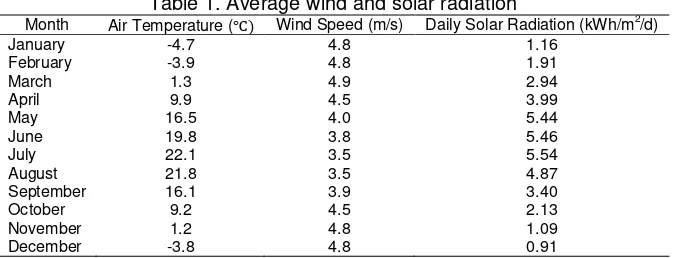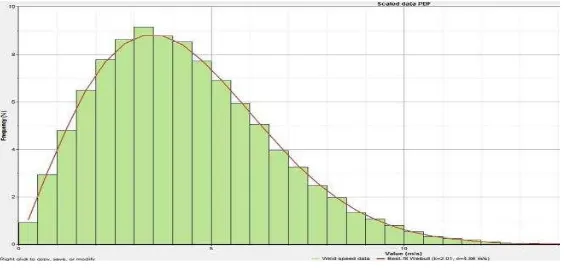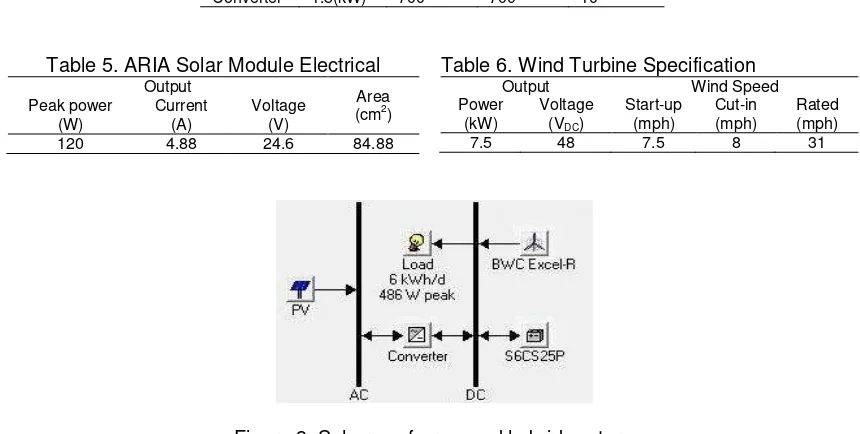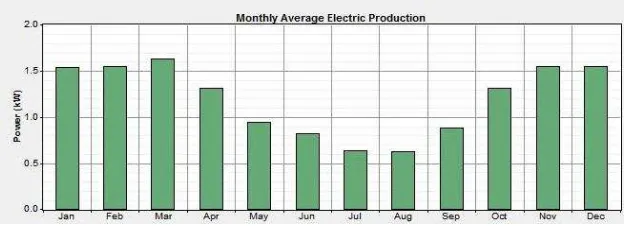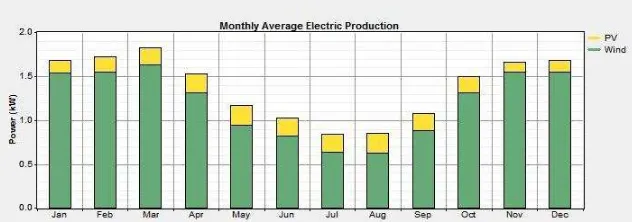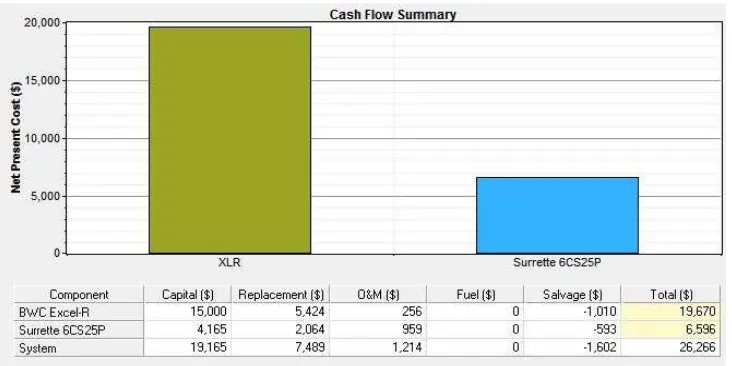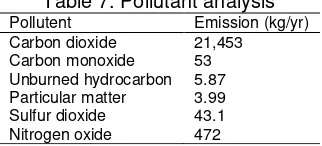DOI: 10.12928/TELKOMNIKA.v15i2.6111 746
Techno-Economic Analysis of Stand-Alone Hybrid
Energy System for the Electrification of Iran Drilling Oil
Rigs
Abdullah Asuhaimi Mohd Zin1, Mehdi Moradi*2, Jalal Tavalaei3,Amirreza Naderipour4,
Amir Hesam Khavari5, Mohammad Moradi6 1,2,3,4,5
Department of Electrical Power Engineering, Faculty of Electrical Engineering, Universiti Teknologi Malaysia (UTM), Johor, Malaysia
6
Faculty of Electrical Engineering, Islamic Azad University (IAU), Sciences & Research Branch, Tehran, Iran
*Corresponding author, e-mail: mehdi@fkegraduate.utm.my
Abstract
This paper explores the potential of use of stand-alone hybrid wind/solar energy system in electrification of calibrating equipment of drilling oil rig in Iran. To achieve this, different hybrid energy system configurations based on calibration equipment demand are proposed. This study puts emphasis on the energy production and cost of energy from both wind turbine and photovoltaic (PV) in the hybrid system. In addition, to make conditions more realistic, the real meteorological data is used for HOMER software to perform the technical and economic analysis of the hybrid system. Results indicate that the PV array shares more electricity production than the wind turbine generator if both wind turbine and PV array are utilized in the wind/solar hybrid system. Moreover, results show that the operational cost will be reduced by the suggested hybrid system.
Keywords: hybrid energy system, drilling oil rig, HOMER, wind turbine, solar panels
Copyright © 2017 Universitas Ahmad Dahlan. All rights reserved.
1. Introduction
Oil is the most important energy source in world and oil drilling rigs are used for oil extraction. However, oil rig location is not permanent and changes with oil well location [1].
Iran’s oil rigs are scattered in south west which is desert and in inaccessible regions such as
The main contribution of this paper is to identify a configuration among a set of systems that meets the desired system reliability requirements with the lowest electricity unit cost for electrification of calibrating equipment of drilling oil rig in Masjed Soleyman. In this regard, HOMER (Hybrid Optimization of Multiple Energy Resources) software that is developed by National Renewable Energy Laboratory (NREL) was used as the simulation and optimisation tool. To perform analysis with HOMER, Different combinations of PV, batteries, and wind turbine were selected in order to identify the optimal combination of the hydrogen based system.
2. Masjed Soleyman Wind and Solar Characteristics
The availability of renewable energy is the most important factor in energy utilization. Then, economical operation and reliability are evaluated precisely. In the desired location, wind energy, solar energy and solar-thermal energy are accessible. This study is focused on wind/PV/battery to support energy demand.
2.1. Wind Speed
Hourly wind speed and solar radiation data of desired area which has been measured in a year is extracted from NASA website [9]. Table 1 portrays the average wind speed in
Table 2. Electrical consumption of oil operation units Application Voltage (V)
Wind speed remained constant in February and reached 4.9 m/s in March. The average wind speed decreases monthly from 4.5 m/s in April to 3.5 m/s in August. However, it has upward trend from September with 3.9 m/s and reached 4.8 m/s in December. The average wind speed during a year is 4.3 m/s. It is obvious that average wind speed is higher in winter than summer. Moreover, the maximum wind speed in January is 6.5 m/s; but it is minimum in June, a bit more than 4.7 m/s. The maximum wind speed usually occurs between 11 am to 16 pm. Therefore, the wind turbine generates maximum power around afternoon and power generation of wind turbine from midnight until dawn is significantly reduced. Weibull distribution function is used to explain the wind speed in the HOMER software [10]. This function contains
”c” and ”k” parameters which are used in software to extract wind profile [11]. The Weibull coefficients for the desired location are k=1.98 and c=4.87 m/s. The Weibull curves are widely used in statistical analysis. In wind energy analysis, it is used to represent the wind speed probability density function, commonly referred to as the wind speed distribution. The Weibull distribution function is given by [12]:
(2)
(3)
Where is the average wind speed, ) is gamma function,”c” is Weibull scale
parameter, ”k” is the unit less Weibull wind shape parameter, is a particular wind speed. The calculation of Weibull coefficient is shown in Figure 1. The green bars illustrate the wind data and red line is the best-fit Weibull. The wind speed commenced with less than 1.00% frequency, but jumped up to 9.00% frequency at 3.5 m/s. The wind speed fluctuates and start to decrease to zero after 14 m/s. Therefore, the best-fit Weibull coefficient are calculated by HOMER software in Figure 2 are k=1.98 and c=4.87 m/s.
Figure 1. Weibull coefficients
2.2. Solar Radiation Ratio
Figure 2 illustrates daily radiation (bar graph) and clearness index (red line) simultaneously. The average daily radiation is a bit less than 2 kW/m2/d in January. It gradually increases from January and reached a high point of 5.54 kW/m2/d in July. However, daily solar radiation starts to decreases monthly to 0.91 kW/m2/d in December. Hence, the average daily solar radiation is slightly more than 3.24 kW/m2/d. Moreover, clearness index portrays that atmosphere is clean in January and December. The index is 1.00 for February and November, yet it is around 0.8 in March. The clearness index has gone down monthly and dropped to 0.6 in May, which shows the dirtiest atmosphere of the year. June and July are not clear months in the desired location and the index is around 0.65. The clearness index is gradually increased and reached 0.85 in October. Thus, the daily radiation is reflected by clearness index (Figure2). Because of oscillating in maximum power output of wind turbine and PV panel, the authors tried to utilize hybrid system to compensate and improve output power. System lifetime is considered as the lifetime of the solar array, which is 20 years.
2.3. Oil Drilling Rig Specification
The desired location is an oil rig unit that is located at Masjed Soleyman at 32-degree North latitude, 49.3 East longitude and 867 meters above sea level. Oil rig units are built to extract oil and gas from the earth layers. Output oil from wells entered to refinery units and after passing few steps, the gas is separated from oil. Then gas and oil is sent via a pipeline to consumers or export. Oil and gas exploitation units have several power consumptions. Table 2 shows Electrical consumption of oil and gas operation units. DC power is used in oil rig units for calibrating equipment.
Table 3. Oil Rig Calibrators Consumption Equipment Voltage (V) Number Demand (W/h) Transmitter 24 110 1440
The calibrating equipment needs constant power without fluctuating because DC power failure will cause disruption in extraction of oil process. Electrical consumption of oil drilling rig is for three applications: calibration, oil refining unit and public application. The calibrating equipment is using DC voltage of 24 V, but oil refining units are using 380 VAC. Moreover, public units such as pumps, cooling and heating, AC equipment and lighting are using 220 VAC.
2.4. Calibrators’ Consumption of Oil Rig
Based on controlling technology, the power consumption in the oil rig unit varies. However, the voltage and current of calibration equipment does not exceed a few watts per day. The selected oil rig expenses are listed in Table 3. This equipment is used for extraction of 30,000 barrels oil per day. Transmitter, stabilizer, converter, flow computers, gas detectors, relay and switches used 24 VDC voltages in calibration. The oil calibrating unit contains a maximum 140 relays and switches that consume a bit more power than 0.8 kW. However, there are only 5 flow computers and energy demand is 0.56 kW. On the other hand, the maximum power consumed by 110 transmitters is more than 1.4 kW, but the minimum power used is slightly less than 0.35 kW that is used for 30 converters. Transmitters, gas detector, relay and switching equipment exert effective power of around 1.4 kW, 1.2 kW and 0.8 kW, respectively. Combined equipment consumes close to 6 kW per day.
3. Economic Optimization of Hybrid System
This study tried to economically optimize hybrid system, increase reliability, reduce net investment, reduce greenhouse gas emission and use renewable energy in oil rig. The system cost is defined as sum of PV cost (CPV), wind turbine cost (CWT), battery cost (CBAT) and converter cost (CCONV) [13].
(4)
Cost of system components need to be deducted as:
(5)
4. Result and Discussion
The desired oil drilling rig is located onshore in a hot and windy region far from national grid; solar panels, wind turbine and battery are selected to feed the calibrating equipment. Wind turbine (BWC excel-R), solar panels (PV), battery (S6CS25P) and converter specifications are addressed in Table 4 to 6. Calibrators require DC power to control circuits and provide protection on instruments. The output power of wind turbine is a function of wind speed, while the output of solar panels is a function of sun radiation, clouds pattern, air pollution etc. Moreover, the output voltages of selected generation devices are not 24 VDC. Hence, convertor between buses is used to control and regulate receiving end power and voltage. In Figure 3 is shown simulation system scheme in HOMER software.
To supply oil rig calibrators’ consumption, three different modes are as follows:
1. Wind turbine and battery.
2. Wind turbine, Solar panels, battery and convertor. 3. Solar panels, battery and convertor
4.1. Economic Hybrid System
In economic hybrid scenario, a wind turbine and five batteries are chosen. No converter is connecting the described system to calibrator equipment of drilling oil rig, although wind turbine generates DC voltage and the calibrating equipment of oil rig utilize DC voltage. Inherent fluctuation in voltage of wind turbine, depending on average wind speed per month, forced hybrid system customers to use converter between generation side and load. Moreover, wind turbine needs a rectifier with maximum generation of 7.5 kV, which is more than demand. The initial cost for reported system is slightly more than $19,150 and the system operating cost will be $555 per year. The cost of electricity generation by wind turbine and batteries is $0.938 /kWh, which is the minimum price compared to 672 other hybrid cases seen by HOMER software. Finally, total NPC for the economic system is around $26,260. The average power generation of wind turbine is shown in Figure 4. The panels will generate a bit more than 1.5 kW in January, but the generation is increased gradually in March, which is slightly more than 1.55 kW. The energy generations by wind turbine decrease from April until July, which is 1 kW to 0.7 kW. The wind turbine electricity generation slope is upward for August and September with 0.53 kW and a bit less than 0.8 kW, respectively. Wind turbine generation in March is the maximum of the solar energy generation in a year. The power generation is increased in October and reached 1.3 kW. The reduction is continued in November and December. The minimum generation is a bit less than 0.6 kW in July and August.
Figure 4. Average Power Production of PV modules
Therefore, the batteries are required to provide remained power for calibration equipment of oil drilling rig. Battery output power ( ) is calculated by:
(6)
Where is maximum discharge current while V is input voltage. Battery output power in 24 VDC is 27.744 kW and will be 4 times more economical for the described system. In the worst-case scenario of July and August, the wind turbine generates something less than 0.6 kW and one of the batteries can cover 5.2 kWh. Figure 6 focused on cash flow of initial cost of the economic system scenario. It is shown that wind turbine capital cost is $15,000 and it required a bit less than $5,424 in replacement cost. The salvage of wind turbine is $10 and total cost is around $19,670. The capital costs of batteries are 3 times less than wind turbine. However, the batteries replacement cost is only 50% less than wind turbine. The operating and maintenance (O&M) cost of batteries is $770 and $259 for O&M of wind turbine. The total cost of batteries salvage is $593. Wind turbines are designed to exploit the wind energy that exists at a location. Aerodynamic modelling is used to determine the optimum tower height, control systems, number of blades and blade shape. Wind turbines convert wind energy to electricity for distribution. Conventional horizontal axis turbines can be divided into three components:
1. The rotor component, which is approximately 20% of the wind turbine cost, includes the blades for converting wind energy to low speed rotational energy.
converting the low speed incoming rotation to high-speed rotation suitable for generating electricity.
3. The structural support component, which is approximately 15% of the wind turbine cost, includes the tower and rotor yaw mechanism
4.2. Reliable Hybrid System
In this scenario, both wind and solar energy are utilized to provide energy for calibration equipment of oil drilling. This system is highlighted in Figure 5.
Figure 5. Sensitive Result of HOMER Software
The addressed system is a DC wind turbine, a PV panel and two batteries that are connected with a converter to load. The initial cost of hybrid system is slightly less than $22,700, which is 1.8 times more than proposed economical system. Operating cost is $516 per year, which is close to first scenario. Moreover, cost of electricity generation and total NPC are 1.11 times more than proposed economical scenario and reached $1.046/yr and a bit less than $29,000, respectively. Figure 6 portrays wind/PV average energy generation per year.
Figure 6. Average power generation of Wind/PV hybrid system
The average generation is 1.8 kW in January and jumped to maximum generation of a bit less than 2.0 kW in March. The generation is reduced to 0.9 kW until July, yet it fluctuated in August and touched 1.8 kW in November and December. Although wind power penetration is more dominant in all months, it is not constant and oscillates significantly. The average wind generation is 1.1 kW per year, reaching a peak in March with 1.7 kW. Furthermore, the minimum wind generation occurred in July with 0.65 kW. The PV panel generation in July is 0.25 kW. Hence, July is seen as the worst-case scenario of this hybrid system. Two batteries will support the proposed system by maximum output power of 55.488 kWh. In this proposed reliable hybrid system, PV penetration is 13% and wind turbine is 87%. Figure 7 illustrates the cash flow of PV/wind/ battery system. This cash flow is similar with cash flow of Figure 8.
Figure 7. Cash flow of Reliable scenario
Figure 8. Cash flow of Economic scenario
4.3. Supplying Equipment with National Grid
In this section, it is assumed that an oil rig is supplied by national grid. For this reason, overhead line or cable is needed for electrification of oil rig equipment. Distance of oil rig to national grid, soil properties and the nearest substation determine initial cost of electrification by grid. Designer of grid is required to clarify the number of towers and insulators, type of tower and insulator and length of cable/wire. Finally, a step down transformer will reduce the voltage to desired level and a converter will convert it to DC power. The information and price of related equipment are extracted from Iran, Ministry of Power and Energy/distribution voltage. The initial cost of a normal 25 kVA transformer is around $4,000 and initial cost on national grid is
$50,000/km. Now, assume that oil rig distance to national grid is ”L”. The system cost (CSYS) is summation of national grid cost (CNG) multiplied by length of national grid, transformer cost (CT) and converter cost (CCON) as follows:
(7)
4.4. Single Generator and Pollution Analysis
This section discusses the comparison of electrification of oil calibrating equipment with a diesel generator instead of hybrid system. A generator is selected to provide 6 kW for calibrating equipment in series with a converter. The initial cost for an AC generator is $2,400 and operating cost expenditure is $8,600/yr. Moreover, the electricity cost by this method is $4.401/kWh. Initial cost of converter is $800 and the system total NPC is $113,137. Although the initial cost of diesel generator is less than hybrid system and grid, operating cost of diesel generator in comparison with suggested system makes customers reluctant. Furthermore, this generator has burned 8147 liters diesel to generate 6 kW electrical powers. Analysis of pollutant emission by HOMER software portrays the desired hybrid system as decreasing greenhouse gases. The rate of carbon dioxide emission for supplying calibrator’s equipment of oil drilling rig (6 kW/h and 21.9 MW/h/yr) by diesel generator is portrayed in Table 7.
Table 7. Pollutant analysis
Emission of carbon dioxide and carbon monoxide due to burning diesel are 21,453 kg/yr and 53 kg/yr respectively. The rate of other pollutant such as nitrogen oxide, sulfur dioxide, unburned hydrocarbon and particular matter are 472 kg/yr, 43.1 kg/yr, 5.87 kg/yr and 3.99 kg/yr, respectively. Providing energy for calibrating equipment of oil drilling rig by hybrid system is preventing environmental pollutant release that is around 22 tons/yr. Hybrid system utilization helps to green energy and save fossil fuel resources for future generation.
5. Conclusion
Due to increase in energy demand, resource limitation and increasing environmental pollution of fossil fuel combustion, penetration of renewable energy in generation is enhanced. This paper is focused on effective cost analysis of oil rig calibrators consumption by HOMER software. The result analysis has shown that two effective scenarios need to be described, economic scenario and reliable scenario. In economic scenario, wind turbine/ battery hybrid system is used to feed calibration equipment of oil drilling rig with $19,165 for initial cost and $0.938/kWh on cost of electricity generation. In the other case, wind/PV/battery provides energy. Although the initial cost and cost of electricity generation is increased by around 18%, hybrid energy use is more reliable. Wind generation supports PV generation between sunset and sunrise. Moreover, wind/PV/battery hybrid system dependency on battery is 50% reduced.
Acknowledgements
The authors sincerely would like to express their appreciation to the Universiti Teknologi Malaysia (UTM) for supporting this work through FRGS Grant (Vote No : 4F911) and Ministry of Higher Education (MOHE) for providing funds to carry out the research reported in this paper.
References
[1] Bordenave M, Hegre J. Current distribution of oil and gas fields in the Zagros Fold Belt of Iran and contiguous offshore as the result of the petroleum systems. Geological Society, London, Special
Publications. 2010; 330(1): 291-353.
[2] Khodashenas A, Roayaei E, Abtahi SM, Ardalani E. Evaluation of naturally occurring radioactive materials (NORM) in the South Western oil wells of Iran. Journal of environmental radioactivity. 2012; 109: 71-75.
[4] Derakhshanalavijeh R, Teixeira JMC. Cost overrun in construction projects in developing countries, Gas-Oil industry of Iran as a case study. Journal of Civil Engineering and Management. 2016: 1-12. [5] Bhattacharyya SC, Palit D. Mini-grid based off-grid electrification to enhance electricity access in
developing countries: What policies may be required?. Energy Policy. 2016; 94: 166-178.
[6] Bhatt A, Sharma M, Saini R. Feasibility and sensitivity analysis of an off-grid micro hydro– photovoltaic–biomass and biogas–diesel–battery hybrid energy system for a remote area in Uttarakhand state, India. Renewable and Sustainable Energy Reviews. 2016; 61: 53-69.
[7] Iqbal Z. Evaluation of Solar Hybrid Power Systems and its Efficacy in the UAE Market. Int J of
Thermal & Environmental Engineering. 2016; 11(1): 73-78.
[8] Aamir M, Kalwar KA, Mekhilef S. Review: Uninterruptible Power Supply (UPS) system. Renewable
and Sustainable Energy Reviews. 2016; 58:1395-1410.
[9] Mostafaeipour A, Qolipour M, Mohammadi K. Evaluation of installing photovoltaic plants using a hybrid approach for Khuzestan province, Iran. Renewable and Sustainable Energy Reviews. 2016; 60: 60-74.
[10] Zhou W, Lou C, Li Z, Lu L, Yang H. Current status of research on optimum sizing of stand-alone hybrid solar–wind power generation systems. Applied Energy. 2010; 87(2): 380-389.
[11] Carta JA, Ramirez P, Velazquez S. A review of wind speed probability distributions used in wind energy analysis: Case studies in the Canary Islands. Renewable and Sustainable Energy Reviews. 2009; 13(5): 933-955.
[12] Cao QV. Predicting parameters of a Weibull function for modeling diameter distribution. Forest
science. 2004; 50(5): 682-685.
